Introduction
The aviation industry is evolving rapidly, with airlines constantly seeking new ways to stay competitive, improve passenger experiences, and unlock untapped revenue streams. Virtual Interlining, powered by advanced technology and sophisticated algorithms, provides an innovative path to greater connectivity, better load factors, and operational efficiency.
With innovative services like Airsiders’ Check-Thru solution, which automates baggage transfers even for virtual interlining – airlines can transform the industry and how passengers travel.
Problem
Connectivity remains a key challenge in the aviation industry. Many smaller or regional airlines struggle to expand their reach without formal codeshare or interline agreements, while major carriers are often limited by complex and costly legacy systems. Passengers seeking self-connecting flights face the inconvenience of reclaiming and rechecking baggage during layovers, leading to a less-than-ideal travel experience and missed opportunities for airlines to win loyalty.
Airline managers in operational, network, alliance, or distribution teams grapple with the logistical and financial challenges of enabling seamless connections across carriers. How can they increase connectivity, enhance passenger satisfaction, and streamline operations without massive investments or overhauls?
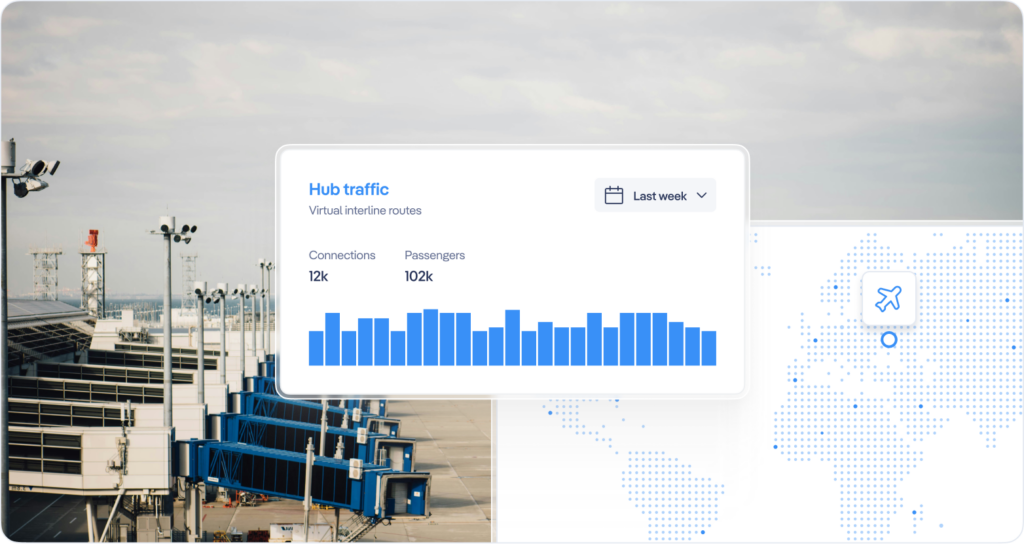
Solution
Virtual Interlining unlocks new opportunities for airlines, enabling seamless connections between carriers without the need for traditional interline or codeshare agreements. Airsiders’ advanced technology takes this a step further with its innovative Check-Thru service, which ensures automatic baggage transfers between flights. This eliminates the hassle of passengers rechecking their bags and creates a smoother and more efficient travel experience.
For airlines, these solutions mean the ability to offer expanded itinerary options, tap into new markets, and increase revenue without the complexities of formal partnerships. By enhancing connectivity and reducing friction in self-connecting journeys, airlines can attract more passengers and improve load factors, strengthening their competitive positioning.
The result? A win-win for airlines and their customers. Travelers benefit from stress-free baggage transfers and more convenient routing options, while airlines unlock new revenue streams, optimize capacity, and enhance customer satisfaction.
Get in Touch
Ready to unlock new market potential for your airline? Discover how Airsiders’ Virtual Interlining and Check-Thru solutions can transform your operations and passenger experience. Get in touch with us today to learn more or schedule a demo.
Introduction
Online Travel Agencies (OTAs) are in a unique position to revolutionize air travel by leveraging Virtual Interlining (VI) opportunities. With the right technology, OTAs can create seamless, cost-effective itineraries across multiple airlines, offering travelers more choice and flexibility. However, the true game-changer for those selling self-connected itineraries lies in providing a Check-Thru service – automated baggage transfer at the connecting airport – allowing passengers getting their checked baggage directly at the final destination (similar to regular interlining) for a stress-free journey. This innovation not only enhances the passenger experience, but also creates new revenue streams for airlines and airports.
The Problem: Fragmented Travel Experience
Today’s travelers often book multi-airline itineraries to save money or reach destinations not reachable with a single airline or airlines cooperation (codeshare/interlining). However, self-connected itineraries present challenges, including having two separate tickets and no support from the airlines in the event of a missing flight connection. The other big task for passengers is to collect the checked baggage at the transfer airport and then check-in again for the next flight. These pain points could create some discomfort for travellers and reduce customer satisfaction, causing also complaints or negative reviews towards the OTA who sold them the itinerary.
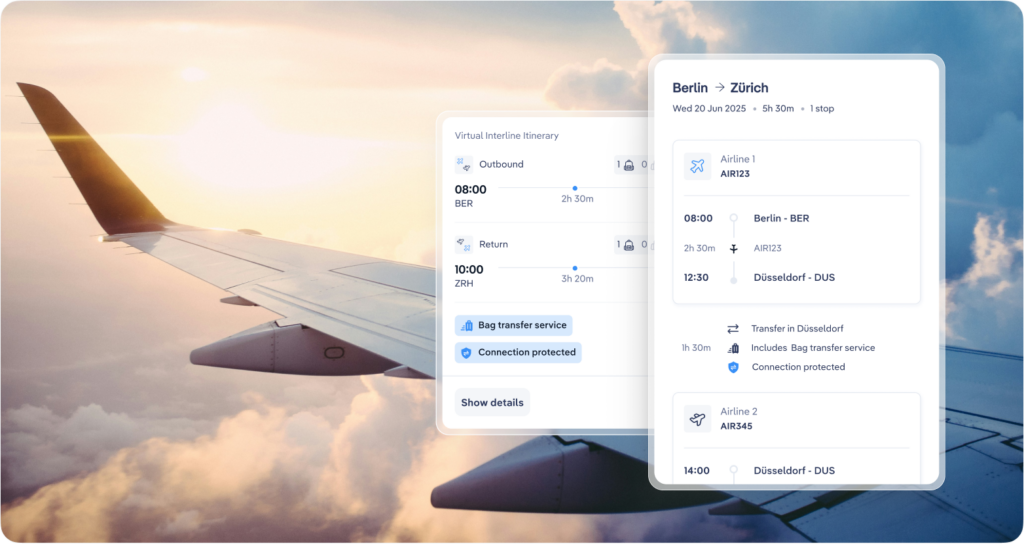
The Solution: Virtual Interlining with Check-Thru
Offering to customers a Check-Thru service for virtual interlined itineraries, where baggage is automatically transferred between flights, allows streamlined transfers, takes away the stress from passengers and it can also make those who didn’t do it before consider the possibility of booking these self-connect itineraries. Check-thru service becomes also a new source of revenue for the OTAs selling it as ancillary.
Major benefits for OTAs:
- Enhanced customer satisfaction: While most of the OTAs selling virtual interline itineraries already offer connection guarantee insurance, Check-Thru service represents the missing piece to ensure to customers a true seamless journey from origin to final destination with completely different travel experience perception and enhanced customer satisfaction.
- New Revenue Opportunities: Check-Thru service represents not only a new ancillary revenue source for OTAs, but could also lead to an increased number of bookings, with customers attracted by the competitive price of virtual interlined itineraries, finally bookable with peace of mind due to connection guarantee and bag transfer service.
- Increase customers loyalty: No-stress travel experiences together with competitive fares could lead in satisfied returning customers and increase loyalty.
Airsiders technology provides OTAs with a solution to enable them selling virtual interlined itineraries with connection guarantee to cover disruptions plus the possibility to offer to customers unique automated baggage transfers at selected VI hub airports, ensuring a smooth, hassle-free experience for passengers while unlocking new potential revenue for the OTAs.
Get in Touch
OTAs, airlines, and airports that embrace Virtual Interlining with Check-Thru will lead the future of connected travel. If you’re ready to boost your passenger experience and expand your network, contact us today to explore how our solutions can integrate seamlessly with your operations.
Introduction
Self-connecting travellers make up a significant segment of traffic at many major airports, particularly those with a good mix of legacy and low-cost carriers. These travellers — often difficult to identify in airport statistics due to itineraries including two separate airline bookings (PNRs) — take advantage of virtual interline itineraries offered by major OTAs to find the most convenient options to reach their desired destinations. Along with price, the ease of connecting and catching the next flight at a given airport is a key factor in decision-making for these customers.
The Baggage Handling Challange
The biggest challenge for self-connecting passengers is managing checked baggage. Where passengers with cabin baggage can stay airside and proceed directly to their connecting flight’s departure gate, checked baggage requires them to proceed to baggage reclaim, collect, and then drop off at the second airline’s check-in counter. They must then pass through security again to return airside. When a transfer visa is required to enter the country, this process becomes even more complicated.

Airsiders Solution
This is where Airsiders baggage check-through technology can enhance the airport experience for self-connecting passengers. Our technology enables passengers to check their baggage at the origin airport and collect it at their final destination, allowing them to stay airside during the transfer and relax while waiting for their next flight. Meanwhile, their checked bag is identified, retagged (if necessary), forwarded to the connecting flight, and tracked throughout every step of the journey.
Benefits for Passengers
- Convenience: Passengers can include checked baggage in their self-connection itineraries without worrying about collecting it at the transfer airport, as with any regular connecting flight.
- Peace of Mind: Real-time tracking and updates reassure passengers of the whereabouts of their luggage.
- Reduced Stress: This streamlined process alleviates the stress and anxiety associated with baggage collection during transfers.
Benefits for Airports
- Enhanced Passenger Experience: The convenience and peace of mind provided by Airsiders baggage check-through technology significantly improves the overall passenger experience.
- Stimulation of Virtual Interlining (VI) Traffic: With the seamless baggage service and transfer process, the airport becomes a preferred connecting hub for self-connecting passengers, attracting more traffic.
- Increased Revenue: By keeping passengers airside and freeing them from baggage-related duties, airports give travellers more time to relax and enjoy airport shopping and services.
Conclusion
Airsiders baggage check-through technology has the potential to transform the airport experience for passengers while attracting additional virtual interline traffic. By streamlining baggage handling processes for self-connecting passengers and enabling seamless transfers, the technology unlocks new possibilities for efficiency, convenience, and passenger satisfaction. As the aviation industry continues to evolve, innovative solutions like Airsiders baggage check-through will play a pivotal role in shaping the future of air travel.
Get in Touch
Airsiders’ Baggage Check-Through Technology is transforming how airlines and airports approach interlining, turning operational challenges into opportunities for growth. Ready to unlock your airport’s or airline’s potential? Contact us today to learn how our solutions can empower your team, delight your passengers, and redefine the travel experience.
Introduction
The sudden bankruptcy of a hub carrier can send shockwaves through the airline industry, disrupting operations, connectivity, and revenue streams for airports and airlines alike. Traditional interlining arrangements often crumble under these circumstances, leaving passengers stranded and partnerships in disarray. Virtual interlining networks, however, offer a resilient solution, ensuring continuity and minimizing disruptions.
Problem
When a hub carrier declares bankruptcy, the consequences ripple across the ecosystem:
- Airports lose significant passenger volumes and revenue streams tied to the hub carrier’s operations.
- Airlines relying on connections via the hub lose valuable feeder traffic, impacting network profitability.
- Passengers are left stranded with canceled flights, complicating the journey experience and eroding trust.
- Traditional interline agreements, dependent on legacy contracts, fail to adapt quickly to such sudden shocks. Recovery for affected airports and airlines often takes years.
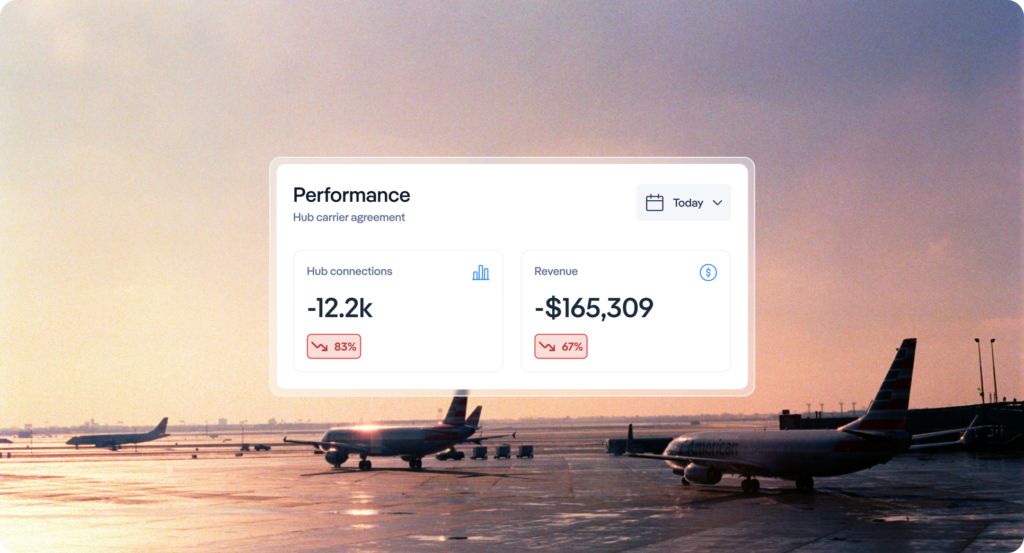
Solution
Virtual interlining provides a more agile and resilient alternative. By leveraging technology to connect flights across airlines without requiring formal interline agreements, Airsiders enables:
- Dynamic Connectivity: Rapid reconfiguration of flight options to bypass the collapsed hub carrier, ensuring uninterrupted passenger itineraries.
- Check-thru Services: Seamless baggage transfers through our automated Check-thru service, even when combining non-partner airlines.
- Passenger Experience: Proactive rebooking and alternative itineraries ensure passengers reach their destinations with minimal disruption.
- Revenue Recovery: Airports and airlines can quickly restore traffic flows by utilizing virtual interlining to sustain connectivity and retain feeder traffic.
Our solution empowers airports and airlines to future-proof their networks, maintaining robust connectivity regardless of external disruptions.
Get in Touch
Want to learn how virtual interlining can safeguard your operations against hub carrier bankruptcies? Reach out to our team today for tailored solutions that keep your passengers moving and your networks thriving.
Introduction
The aviation industry is in a constant state of evolution, and virtual interlining has emerged as a game-changer. By enabling passengers to connect between airlines that don’t traditionally partner, virtual interlining opens up new opportunities for airports and airlines to optimize operations and boost connectivity. As we step into 2025, certain hubs are poised to lead the way in this space. This article highlights the top 10 virtual interlining hubs to watch, showcasing why they stand out and how they’re leveraging this innovative solution to redefine passenger journeys.
Top 10 Virtual Interlining Hubs
1. Istanbul Sabiha Gökçen Airport (SAW): As Istanbul’s secondary airport, SAW is strategically positioned to handle increasing passenger volumes. Its efficient operations and growing network of routes and list of carriers make it a rising star in virtual interlining.
2. Rome Fiumicino Airport (FCO): FCO serves as Italy’s primary international gateway, offering extensive connections across Europe and beyond. Its commitment to modernizing infrastructure and ADRs innovation efforts lead the way to connecting the growing share of LCCs with its list of full service carriers offering an extensive international route network.
3. Kuala Lumpur International Airport (KUL): The biggest virtual interlining hub in Southeast Asia, mainly driven by AirAsia. KUL supports a diverse range of carriers and has enormous growth potential in terms of self-connecting traffic. Its focus on improving operational efficiency aligns well with virtual interlining strategies.
4. Milan Malpensa Airport (MXP): MXP is the biggest hub in Northern Italy, connecting travelers to both domestic and international destinations worldwide. Base of the biggest European LCCs and served by the major legacy international carriers, the airport offers unparalleled opportunities for self-connecting travellers. The airport has been one of the pioneers in understanding the potential of virtual interlining and developing solutions to support this traffic.
5. London Gatwick Airport (LGW): As one of London’s busiest airports, LGW stands out with its efficient handling of low-cost and full-service carriers. Its strategic location makes it an important player in virtual interlining. While currently LGW doesn’t have an airport supported connecting program, as it used to have in the past, demand is rock solid.
6. Barcelona-El Prat Airport (BCN): Serving as a key gateway to Spain, BCN’s strong network of European and intercontinental flights positions it as a virtual interlining hub to watch. Next to strong LCC presence and having Vueling serving BCN as its main hub, lots of connectivity is provided and subsequently lots of travellers enjoy the transfer here.
7. Madrid-Barajas Adolfo Suárez Airport (MAD): Serving as a key link between Europe and Latin America, MAD’s strategic location and commitment to enhancing passenger connectivity position it as an important virtual interlining hub.
8. Athens International Airport (ATH): As a gateway to Greece and the Eastern Mediterranean, ATH benefits from a mix of legacy and low-cost carriers. Its focus on digital transformation supports virtual interlining growth.
9. Abu Dhabi International Airport (AUH): A growing hub in the Middle East, AUH is leveraging its strategic location and new terminal facilities to strengthen its role in virtual interlining. In 2024 Abu Dhabi Airports was ranked as the fastest growing airport in the world in the category of > 25 million passengers.
10. Budapest Ferenc Liszt International Airport (BUD): BUD is an emerging player in Central Europe, offering efficient operations and expanding connections that cater to virtual interlining needs connecting Eastern Europe and Middle East towards Western Europe. With a strong LCC presence, numbers are growing steadily.
What Airsiders Offers?
At Airsiders, we specialize in enabling seamless virtual interlining solutions for airlines and airports. Our proprietary Check-thru service automatically transfers passengers’ baggage to their destination, eliminating the hassle of re-checking luggage during layovers. With a robust platform that integrates real-time data, advanced technology, and a focus on operational efficiency, we empower hubs to:
- Reduce connection times
- Improve passenger satisfaction
- Enhance operational performance
By partnering with Airsiders, hubs can transform their virtual interlining operations into a competitive advantage, providing a superior travel experience.
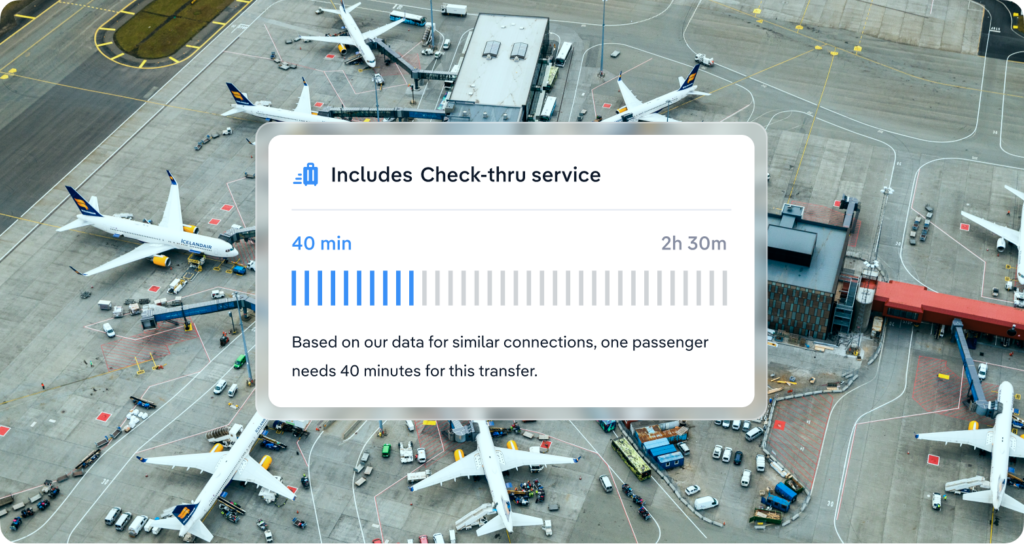
Get in Touch
Interested in elevating your hub’s virtual interlining capabilities? Airsiders can help you implement seamless Check-thru services and optimize your operations. Contact us today to learn how our innovative solutions can position your airport or airline as a leader in virtual interlining.
Introduction
Empty seats on flights represent not only lost revenue for airlines but also missed opportunities to optimize demand. Leveraging innovative solutions like Virtual Interlining (VI) can help airlines create new connections, attract more passengers, and fill seats that might otherwise remain unoccupied.
Problem
Airlines often struggle to fill seats on underutilized routes or during off-peak periods. Traditional partnerships such as interlining and codeshare agreements tend to be inflexible and involve complex negotiations. This constrains the ability of airlines to broaden their networks or adapt quickly to shifting market conditions.
Meanwhile, many passengers piece together self-connecting itineraries involving multiple carriers to find cheaper or more convenient travel options. While this can benefit travelers, it bypasses airline-controlled booking channels and leads to operational difficulties, such as passengers having to re-check their luggage or being unable to transfer due to missing visas. These factors collectively result in lower load factors and unrealized revenue potential.
Solution
Virtual Interlining connects flights from different carriers, enabling seamless itineraries without the need for formal agreements. This creates expanded route options and enhances competitiveness, which can attract more passengers and boost seat occupancy.
Additionally, solutions like Airsiders’ unique Check-thru service address critical pain points for passengers. This service streamlines baggage transfer between connecting flights, eliminating the need for passengers to retrieve and re-check bags during layovers. By making these itineraries more seamless and convenient, Check-thru significantly improves the traveler experience and increases the appeal of VI itineraries.
For airlines, the benefits go beyond passenger satisfaction. By embracing VI and leveraging innovative tools like Check-thru, they can unlock revenue from unused capacity, cater to passengers seeking flexibility and cost-effective travel, and achieve higher load factors.
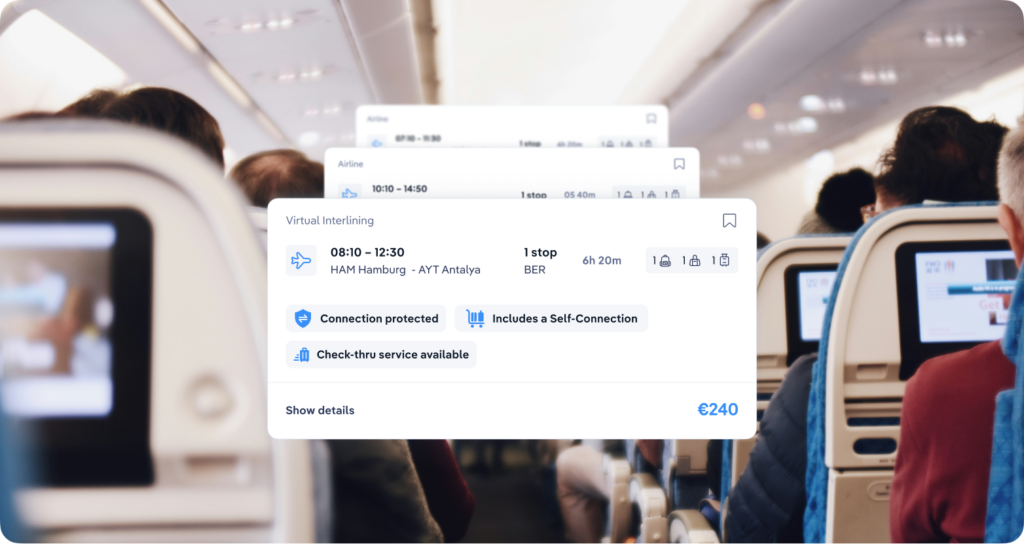
Looking Ahead
Airlines that adapt to Virtual Interlining can maximize its benefits by integrating Airsiders’ Check-thru service. This combination helps address unused seat capacity, enhances passenger satisfaction, and streamlines operations. By leveraging these solutions, airlines can better steer demand toward available capacity, improve efficiency, and elevate the overall travel experience. Contact us today to learn more.
Introduction
The rise of self-connecting travel has reshaped passenger behavior, offering flexibility and cost savings. However, it also introduces operational challenges for airports, from baggage handling inefficiencies to passenger confusion. How can airports adapt to this growing trend while maintaining seamless operations and delivering a superior traveler experience?
Problem
Self-connecting passengers often face logistical hurdles, such as reclaiming and rechecking baggage, navigating between terminals, and managing tight connection times. For airports, these issues can lead to operational strain, reduced passenger satisfaction, and missed opportunities to attract more airlines and travelers. Without optimized solutions, self-connections can become a source of frustration rather than convenience.
Solution
Airsiders offers innovative solutions that transform airport operations to meet the needs of self-connecting passengers. Our technology facilitates automated baggage transfers, ensuring luggage seamlessly moves from the first flight to the next without requiring passenger intervention. Additionally, we streamline processes to enable smooth connections, even for itineraries involving multiple airlines.
By implementing Airsiders’ virtual interlining solutions, airports can:
- Improve passenger satisfaction: Provide travelers with a stress-free experience, reducing confusion and wait times.
- Enhance operational efficiency: Minimize congestion at baggage claim and check-in areas, freeing up resources.
- Boost connectivity: Position your airport as a preferred hub for self-connecting travelers and airlines.
With Airsiders, airports can transform into hubs of seamless connectivity, accommodating the growing self-connection trend while maintaining efficient operations.
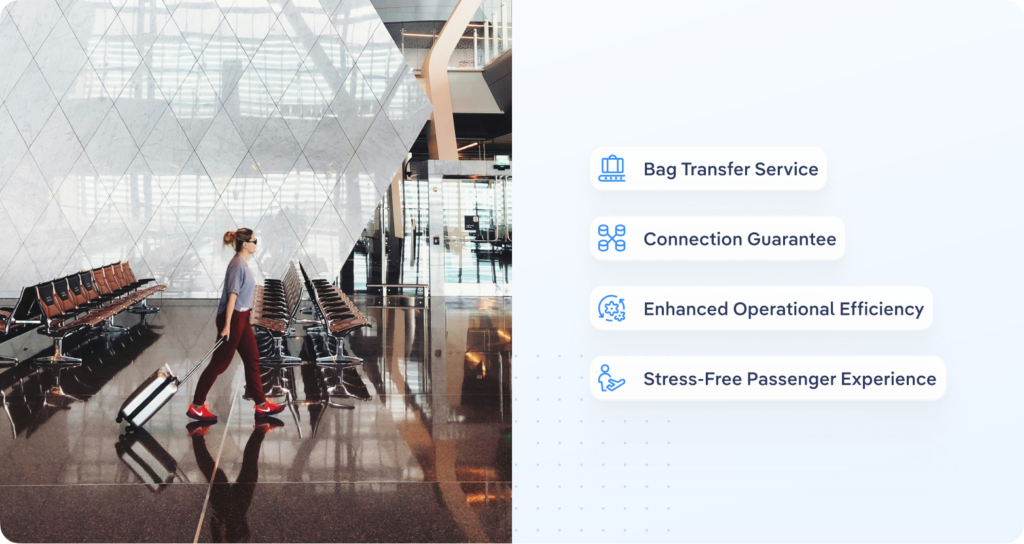
Get in Touch
Want to elevate your airport’s operations and better serve self-connecting passengers? Contact Airsiders today to discover how our solutions can help your airport stay ahead in an evolving travel landscape.
Introduction
Regional carriers face a unique challenge: expanding their networks while operating within tight resource constraints. Virtual interlining provides an innovative way for these airlines to extend their reach, offering passengers more destinations and seamless travel experiences. How can this approach help regional carriers thrive in an increasingly competitive market?
Problem
Regional airlines often operate limited fleets and serve specific geographic areas, making it difficult to compete with larger carriers and alliances. Traditional codeshare agreements and interline partnerships are resource-intensive, leaving regional airlines with fewer options to grow their connectivity. Passengers, meanwhile, frequently deal with the inconvenience of booking separate tickets and managing their baggage during self-connecting journeys, impacting their overall experience.
Solution
Airsiders offers a 360° solution, which includes a White-Label or API technology to empower regional carriers and extend their networks with ease. By integrating Airsiders’ comprehensive content, carriers can connect their flights with those of other airlines, creating unique, cost-effective itineraries.
This approach is further enhanced by our Check-Thru service, which automates baggage transfers for self-connecting passengers, ensuring a seamless experience from start to finish.
With Airsiders’ virtual interlining technology, regional airlines can:
- Boost additional traffic by attracting passengers seeking broader travel options.
- Extend their network beyond their own routes without the complexities of alliances.
- Increase connectivity with access to Airsiders’ expansive virtual interline content.
- Improve the passenger experience through effortless booking and automated baggage handling.
Our solution not only drives revenue growth but also positions regional carriers as competitive players in today’s dynamic aviation landscape.
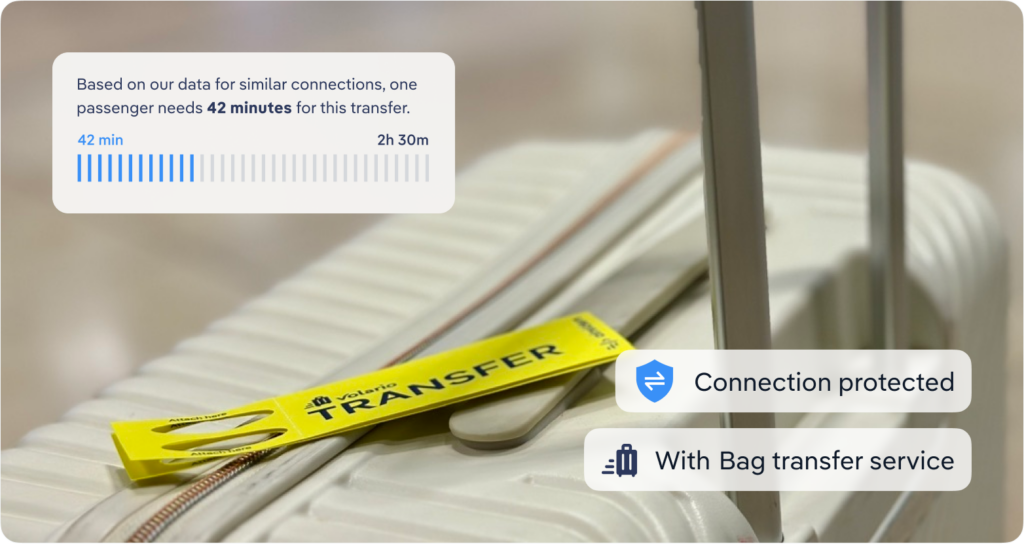
Get in Touch
Ready to expand your regional airline’s network and drive growth? Contact Airsiders today to discover how our virtual interlining solutions and Check-Thru service can transform your business.
Introduction
Efficient baggage handling is a cornerstone of smooth airport operations. Delays, mishandled luggage, and passenger dissatisfaction can severely impact the reputation and profitability of airlines and airports. As the aviation industry evolves, travelers increasingly expect seamless connections and hassle-free baggage transfers, particularly for complex itineraries involving multiple carriers.
Problem
Traditional interline baggage handling relies heavily on complex agreements between airlines, often leaving airports as mere facilitators. This approach is inefficient and prone to errors, especially for virtual interlining, where such agreements are absent. Passengers are frequently burdened with rechecking baggage during transfers, causing delays, frustration, and potential missed connections.
For airlines and airports, the operational strain of managing unoptimized baggage processes leads to increased costs, resource inefficiencies, and dissatisfied travelers—a situation that demands a smarter, tech-driven solution.
Solution
With Airsiders’ innovative Check-thru service, we’re redefining how airports and airlines work together to deliver seamless interline baggage transfers, transforming the travel experience for passengers while optimizing operational workflows. Check-thru service revolutionizes baggage handling by automating and streamlining the transfer process. Our advanced technology integrates seamlessly into existing airline and airport systems, enabling airports to take an active role in ensuring baggage is automatically routed to the passenger’s final destination for virtual interline itineraries.
By leveraging our innovative platform:
- Passengers enjoy a stress-free journey, no longer needing to retrieve and recheck their luggage.
- Airports enhance their value proposition, actively contributing to better passenger experiences and reducing on-ground delays.
- Airlines minimize operational complexity, optimizing their network connectivity without needing extensive interline agreements.
Our solution uses intelligent routing algorithms, real-time baggage tracking, and comprehensive reporting, ensuring transparency and reliability across the board.

Get in Touch
At Airsiders, we’re committed to reshaping the future of interline travel through seamless solutions. Want to learn how our Check-thru service can revolutionize your airport’s baggage handling operations? Let’s connect. Contact us today to explore the possibilities of smarter, more efficient airport operations.
Introduction
In an evolving travel landscape, the airline and airport industries are seeking efficient and cost-effective solutions to address connectivity gaps. Virtual interlining offers the future of collaboration, emerging as a competitor to traditional interlining agreements. Here’s why virtual interlining is poised to redefine the industry.
Problem
Traditional interlining agreements are essential for passenger connections, but they come with significant challenges that hinder efficiency and limit growth opportunities:
- Lack of Flexibility: Airlines are constrained by existing partnerships and rigid routes, reducing their ability to offer adaptable, real-time connections.
- Operational Inefficiencies: Legacy interlining arrangements require manual processing and coordination between multiple carriers and airports, which increases delays and the likelihood of operational errors.
- Limited Network Expansion: Airlines and airports can only offer a finite range of connections, missing out on lucrative opportunities to partner with additional carriers without costly agreements.
- Baggage Transfer Bottlenecks: Without automation, handling baggage for multi-carrier journeys often results in lost luggage or long transfer times, leading to a poor passenger experience.
- High Costs for Prorating: Traditional interlining agreements often involve complex prorating systems, which incur additional administrative costs for airlines, adding complexity and financial strain to the process.
Solution
Virtual interlining provides an innovative solution by offering greater flexibility, connectivity, and automation. Airlines and airports can collaborate without being tied to traditional interlining agreements, unlocking more diverse, on-demand connections that can address passenger needs in real-time.
Virtual interlining mitigates all of the above challenges, enabling smoother connections, lower operational costs, and increased route flexibility. Furthermore, the development of Check-thru, a service developed by Airsiders, has addressed the last missing piece of the virtual interlining puzzle. This solution ensures that baggage is seamlessly transferred to the final destination, helping reduce minimum connecting times, lower administrative costs, and enhance customer satisfaction, without requiring costly interline agreements.

Get in Touch
Want to learn how virtual interlining can revolutionize your operations? Get in touch with us today to explore how our solutions can help streamline your processes, improve interline collaboration, and create a seamless passenger experience.